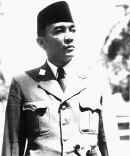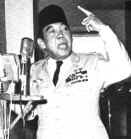|

A young Sukarno reading the Declaration of Independence



Sukarno signs the Supersemar as Suharto looks on
|
Sukarno was born on 6 June 1901 in Blitar, near Surabaya, to school teacher, Raden Sukemi Sosrodihardjo, and his Balinese wife, Ida Nyoman Rai. He was born Kusnasosro but was renamed after a series of illnesses. As a child he was known to his friends as Djago (Cock, champion) for his looks, spirit and prowess. As the president he was known as 'Bung Karno'.
During his childhood, Sukarno spent a great deal of time with his grandparents in the village of Tulungagung, where he was exposed to the animism and mysticism of rural Java. At the age of 15, Sukarno was sent to a Dutch secondary school in Surabaya. Whilst in Surabaya he stayed with Omar Said Tjokroaminoto, a prominent civic and religious figure. Tjokroaminoto treated him like son, financed his continuing education and introduced him to many leading Indonesian nationalists. Sukarno eventually married his host’s daughter, Siti Utari, when he was twenty years old. He later divorced her in 1923. He then took another wife, Inggit Garnisih, whom he divorced in 1943. Fatmawati, his third wife, bore five of his children.
Sukarno was endowed with a commanding presence, a radiant personality, a photographic memory and supreme self-confidence. After completing a civil engineering degree at the Bandung Institute of Technology in 1926, Sukarno found his true calling as an orator and politician. He became a supporter of the Indonesian nationalist cause and became involved in number of nationalist organizations, including the Bandung Study Club, the PNI, the PPPKI and PARTINDO
For his challenge to colonialism, Sukarno spent two years in a Dutch jail in Bandung (1929-31) and more than eight years in exile (1933-42). When the Japanese invaded in March 1942, Sukarno was summoned by the Japanese commander and was made his chief adviser and propogandist. Sukarno pressured the Japanese to grant independence to Indonesia. On 1 June 1945 Sukarno defined a new all-encompassing state ideology for Indonesia, the Pancasila. Later on 17 August 1945, he proclaimed independence for the Republic of Indonesia. After a four year struggle against the returning Dutch colonists, sovereignty was finally transferred to the new Republic on 27 December 1949.
Over the next fifteen years Sukarno enjoyed the spoils of the Presidency whilst the Indonesian economy floundered and his people suffered. In 1956 Sukarno dismantled parliamentary democracy and free enterprise, and instituted a system of ‘Guided Democracy’, a pseudonym for dictatorship.
In response to spiralling inflation and a national crisis, regional insurrections broke out in Sumatra and Sulawesi in 1958 and there were numerous attempts were made on Sukarno’s life. In spite of this discontent, Sukarno was still able to stir the Indonesian masses in support of his policies. In the 1960s, he told the USA to ‘go to hell’ with its aid, he pulled Indonesia out of the United Nations, he established links with Moscow and Beijing, and he launched a military ‘Confrontation’ campaign against Malaysia.
Sukarno’s balancing act came to an end on 30 September 1965 when a communist coup was launched. Sukarno was clearly implicated in the plot. In the coup six high ranking Army generals were kidnapped and murdered. The commander of the Army Strategic Reserve, Major General Suharto, led a counter coup against the new regime and quickly seized power. Over the ensuing two years, power was wrested from Sukarno, as a communist purge spread across the country. On 11 March 1966, Sukarno signed the Supersemar, a document which delegated wide powers to Suharto, who subsequently became acting president in March 1967 and then president in March 1968. Sukarno was confined to house arrest.
Sukarno died on 21 June 1970 at the age of 69 of a chronic kidney ailment and numerous complications, including syphilis. More than 500,000 people turned up to pay their last respects in Jakarta. He was later buried next to his mother at Blitar.
 Related Article Related Article
(c) 2001 compiled by [email protected]
|